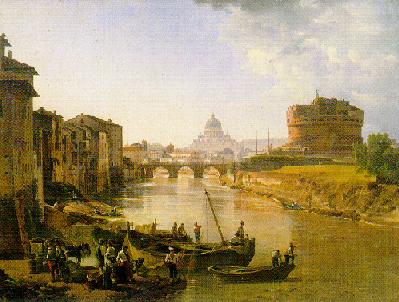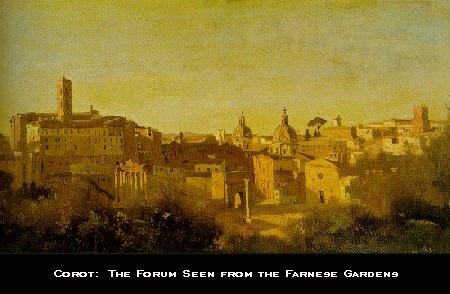Oil on canvas, 45.6 x 67.2 cm. Tretyakov Gallery, Moscow.
Oil on canvas, 45.6 x 67.2 cm. Tretyakov Gallery, Moscow.
 Italian landscapes seem to be very popular among the early Romantic
painters. Such trend knows no boundaries of geography, and extends from
France to Russia. This painting of the Roman landscape is primary example
of such tradition. The main subject, the castle, is portrayed on the right,
but the approach to it is made through the river, the Tiber . The depiction
of people adds to the realism of the painting and fits nicely with the
rest of the composition. The scene is very softly colored: green and yellow
tones dominate, while shading and highlights contribute to the realistic
rendering of this scene. St. Peter is in the background and it seems as
if a soft mist were covering it. That increases the romantic atmosphere
of this painting. The sky is an even more "romantic" element. The light
blue and the white of the clouds are a nice contrast. The focus on the
sky seems to be a characteristic of many Romantic painters. Nature as whole
will be re-introduced as a main focus of composition and not just merely
as a decoration.
Italian landscapes seem to be very popular among the early Romantic
painters. Such trend knows no boundaries of geography, and extends from
France to Russia. This painting of the Roman landscape is primary example
of such tradition. The main subject, the castle, is portrayed on the right,
but the approach to it is made through the river, the Tiber . The depiction
of people adds to the realism of the painting and fits nicely with the
rest of the composition. The scene is very softly colored: green and yellow
tones dominate, while shading and highlights contribute to the realistic
rendering of this scene. St. Peter is in the background and it seems as
if a soft mist were covering it. That increases the romantic atmosphere
of this painting. The sky is an even more "romantic" element. The light
blue and the white of the clouds are a nice contrast. The focus on the
sky seems to be a characteristic of many Romantic painters. Nature as whole
will be re-introduced as a main focus of composition and not just merely
as a decoration.
 The
most interesting aspect of the painting is this contrast between the realism
of a scene with real people attending their everyday chores and the Romantic
look of the sky, the green grass, and the monuments in the background.
While in other painters of the time the Romantic tendency is much more
evident, here it is subtler. It seems that the painter is very much connected
with a more realistic idea of the landscape he is portraying. Artists like
the French, Camille Corot (1796-1875), painted similar landscapes. Like
Shchedrin, Corot was born at the end of the 18th century and fully expressed
himself as a painter in the 19th century. In The Forum Seen from the
Farnese Gardens, painted in 1826 (see above), he portrays a very similar
landscape with a far more Romantic slant. Corot focuses on the landscape
itself while Shchedrin introduces the human element in the composition.
Corot's composition has far more languid colors and is less defined in
contours, Shchedrin's work has highlights and shadows, sharp contours,
and is far more "realistic." This painting offers an extraordinary opportunity
to witness the change in tendencies, from a more "realistic" neoclassical
mode to the Romantic. [S.C.]
The
most interesting aspect of the painting is this contrast between the realism
of a scene with real people attending their everyday chores and the Romantic
look of the sky, the green grass, and the monuments in the background.
While in other painters of the time the Romantic tendency is much more
evident, here it is subtler. It seems that the painter is very much connected
with a more realistic idea of the landscape he is portraying. Artists like
the French, Camille Corot (1796-1875), painted similar landscapes. Like
Shchedrin, Corot was born at the end of the 18th century and fully expressed
himself as a painter in the 19th century. In The Forum Seen from the
Farnese Gardens, painted in 1826 (see above), he portrays a very similar
landscape with a far more Romantic slant. Corot focuses on the landscape
itself while Shchedrin introduces the human element in the composition.
Corot's composition has far more languid colors and is less defined in
contours, Shchedrin's work has highlights and shadows, sharp contours,
and is far more "realistic." This painting offers an extraordinary opportunity
to witness the change in tendencies, from a more "realistic" neoclassical
mode to the Romantic. [S.C.]
